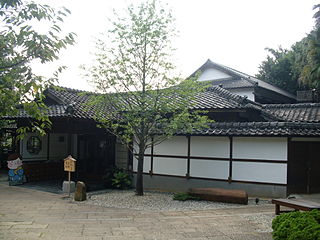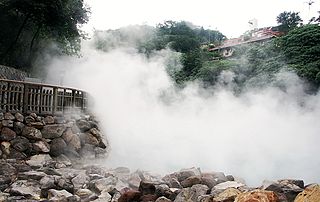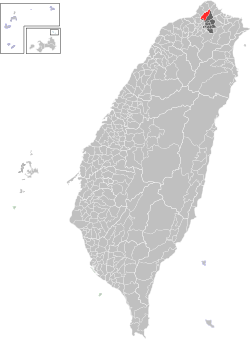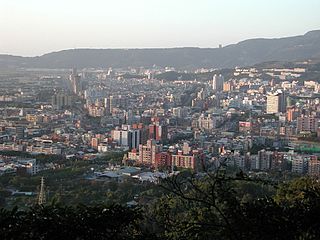
Yangmingshan National Park is one of the nine national parks in Taiwan, located between Taipei and New Taipei City. The districts that house parts of the park grounds include Taipei's Beitou and Shilin Districts; and New Taipei's Wanli, Jinshan and Sanzhi Districts. The National Park is famous for its cherry blossoms, hot springs, sulfur deposits, fumaroles, venomous snakes, and hiking trails, including Taiwan's tallest dormant volcano, Seven Star Mountain (1,120 m).
Yangmingshan Administrative Bureau was a county level administrative body in Taiwan between 1949 and 1973.
The Beitou Cable Car Link Project (北投空中纜車) is the second cable car line in Taipei after the Maokong Gondola. It is one of the major campaign platforms of Ma Ying-jeou, the former Taipei mayor. The proposed 4.9km Beitou cable car line to ferry tourists between Xinbeitou Station and the Yangmingshan National Park would have four stops, the first of which would be built near the skating rink at Chingshui Park. It would continue to Lungfeng Valley on Yangmingshan, the first parking lot in Yangmingshan National Park, and terminate at the second parking lot.

The Taipei Metro Beitou station is a station on Red Line, located in Beitou District, Taipei, Taiwan. The location of station can be traced back the same name station of the now-defunct TRA Tamsui Line and Xinbeitou Line.
Shipai, Shihpai or Ziohbai is a region in Beitou District, Taipei, Taiwan, it includes seven villages (里): Shipai (石牌), Wenlin (文林), Ronghua (榮華), Zhenhua (振華), Yumin (裕民), Fuxing (福興), and Jianmin (建民).

The Grass Mountain Chateau is a former residence of late President of the Republic of China Chiang Kai-shek located in Beitou District, Taipei, Taiwan in Yangmingshan National Park.

The Taipei Metro Guandu station is located in Beitou District, Taipei, Taiwan. It is a station on the Tamsui Line. In the past, the station belonged to the now-defunct TRA Tamsui Line.

The Taipei Metro Mingde station is located in the Beitou District (北投區) of Taipei, Taiwan. The station is on the Tamsui Line, otherwise known as "the red line" by locals. It is also a minor bus transfer point for connections to Tianmu (天母) and Yangmingshan National Park (陽明山).

The Taipei Metro Xinbeitou station is the terminal station on the Xinbeitou Branch Line located in Beitou District, Taipei, Taiwan. The location of the station used to be the terminal station for the now-defunct TRA Xinbeitou Line.

Jinshan District is a rural district on the coast in northern New Taipei, Taiwan. The district draws many visitors each year because of its hot springs and its proximity to Chin Pao San and the Ju Ming Museum. The district is home to the Dharma Drum Buddhist College, an institution of higher learning founded by Dharma Drum Mountain monastics devoted to the principles of Zen Buddhism.

The Beitou Hot Spring Museum is a museum about hot spring in Beitou Park, Beitou District, Taipei, Taiwan.

The Beitou Museum or sometimes called Taiwan Folk Arts Museum is a museum in Beitou District, Taipei, Taiwan.

The Ketagalan Culture Center is a cultural center in Beitou District, Taipei, Taiwan. The cultural center is dedicated to introduce the various Taiwanese Plains Aborigines cultures, including the Ketagalan tribes cultures.

The Beitou Refuse Incineration Plant is an incinerator in Zhoumei Borough, Beitou District, Taipei, Taiwan.

The Thermal Valley is a valley located on the foothill of Yangmingshan National Park in Beitou District, Taipei, Taiwan. This makes Thermal Valley one of the sources of acidic sulfur hot spring in the area. Locals call it as Hell Valley as well. The formula of this mineral water contains Plaster, Alunite, Jarosite, Realgar, Sulfur, and Radium. pH value is between 1.4~1.6, the highest temperature could be reached to 90 Celsius. It was one of the eight attractions and twelve scenic spots in Taiwan during the Japanese colonial period.

The Beitou Park is a park in Beitou District, Taipei, Taiwan.



























